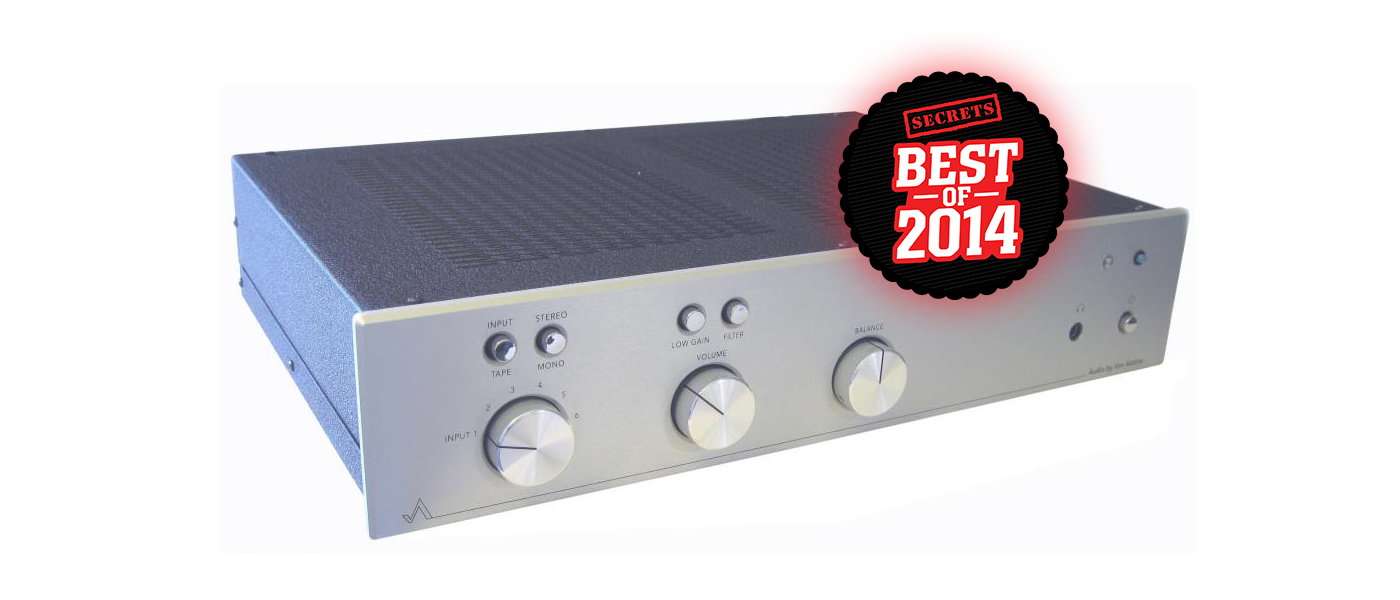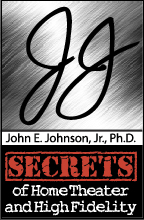Mark Levinson No52 Stereo Preamplifier Review Highlights
Mark Levinson, one of the most respected names in audio, has just released their latest stereo preamplifier design, the No52. Its looks, handling, and performance are what you would expect from Levinson: Extraordinary.
The No52 is in two chassis, one for the control section and one for the analog audio circuitry.
It has enough coax and XLR inputs to take care of anyone’s audio system, and even includes a phono preamp that has as many options for resistive and capacitive loading as do dedicated outboard phono preamplifiers.
The frequency response is flat out to 200 kHz. This is extremely difficult to design, and such a wideband response totally prevents any phase shift in the audible band.
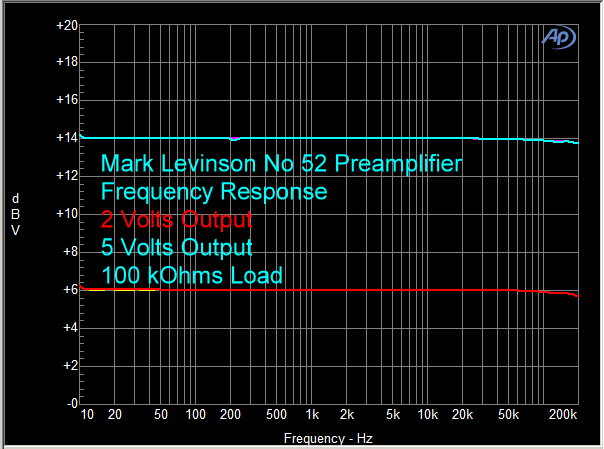
The Mark Levinson No52 is simply an awesome engineering achievement. The sound is absolutely neutral, which is a hallmark of Levinson products. Distortion is as low as can be achieved with technology that is available to today’s electrical engineers.
Mark Levinson No52 Stereo Preamplifier Review Highlights Summary
- Easy to Navigate Inputs
- Extremely neutral sound
- Very low distortion
- Worth the price
Introduction to the Mark Levinson No52 Stereo Preamplifier Review
I have tested many Mark Levinson audio products over the years, and the performance always astounded me. Neutral sound and low distortion are the two phrases that audiophiles, including myself, identify with Levinson.
The No52 is Levinson’s latest, and greatest, preamplifier. They say it’s the best preamplifier they have ever designed. I believe it, and if you audition this product, you will too.
SPECIFICATIONS
- Design: Stereo (Dual Mono) Preamplifier
- Maximum Output Voltage: 16 Volts RMS XLR, 8 Volts RMS RCA Coax
- MFR: 10 Hz – 40 kHz ± 0.2 dB
- Volume Control Range: 80 dB
- Line Stage Gain: 0 dB, +6 dB, +12 dB, +18 dB (Selectable)
- Phono Stage Gain: +40 dB, +60 dB (Selectable)
- Main Volume Control Gain Resolution: 1 dB up to 23 dB, 0.1 dB from 23 dB to 80 dB
- Inputs: 3 x XLR, 4 x RCA, 1 x RCA Phono, 1 x USB-1 for Firmware Updates
- Outputs: 1 x XLR, 1 x RCA, 1 x RCA Record Loop
- Input Impedance: 100 kOhms
- Output Impedance: 20 Ohms XLR, 10 Ohms RCA
- SNR: 120 dB, 20 Hz – 20 kHz
- Dimensions: 8.75″ H (both chassis together) x 17.25″ W x 13″ D
- Weight: 60 Pounds Total
- MSRP: $30,000 USD
- Mark Levinson
- Tags: Mark Levinson, No 52, Preamplifiers, Stereo, Audio
The Design of the Mark Levinson No52 Stereo Preamplifier
Although based on a switching power supply, the Mark Levinson No52 preamplifier still weighs 60 pounds.
There are two chassis that sit one on top of the other. The top one contains the control section, and the bottom one contains the analog audio circuitry.
Following is some information I received from Levinson’s engineers:
The No52 uses both switching and linear power supplies, and the linear supplies still contribute significant weight. The casework and extensive internal shielding comprise most of the weight of the unit.
As in several other Mark Levinson products, the No52 actually re-generates AC power before the final rectification, filtering, and regulation stages. It is this additional stage in the power supply that is unique to these products, as it goes well beyond the basic filtering and isolation functions that most line conditioners (even the really expensive ones) perform.
The functions and signal flow in the No52 power supply are as follows:
1. Separate left and right switching power supplies generate +/-15V DC from the incoming AC mains. These are fully encapsulated supplies, so they are mechanically and electrically very quiet. The power supplies operate at a frequency of 70 kHz.
2. These +/-15V rails supply power to separate left and right class D amplifiers, which use the same proven technology as the very well regarded Crown professional amplifiers. These amplifiers are driven by precision oscillators to produce exceptionally clean, pure, 200 Hz sine waves.
3. These clean 200 Hz sine waves function as the new, re-generated AC waveforms, which drive separate left and right custom toroidal transformers.
4. The transformers each have three secondary windings, all of which are rectified and filtered to produce separate +/-22V and +8V supplies for each channel.
5. Each of these power supplies feeds its own linear voltage regulator. The regulators in turn provide stable +/-18V and +5V supplies for each channel.
6. Finally, one last set of linear regulators provides ultra stable, low noise +/-15V supplies for the left and right channels for critical analog circuitry. These regulators are located inside the audio chassis, close to the circuits they will be powering.
7. Note that completely separate switching power supplies—none of which are connected to anything mentioned above—are used to power the digital control circuits in the No52.
The power supplies do not have—but also do not require—extraordinary amounts of filter capacitance. Switching supplies, because they typically operate at frequencies several orders of magnitude above the 50-60Hz of a simple, conventional, transformer-based linear supply, are able to do their job with considerably smaller capacitors. Also, the stability of the 200 Hz waveforms supplied by the class D amps, as well as the multiple cascaded linear regulators, contribute to making these supplies less dependent on large capacitors.
The preamp has three main gain stages, which operate in Class A, as they are based on high quality audio op-amps, which operate at enhanced bias currents.
1. The input stage uses four low noise, high current op amps connected in a fully balanced instrumentation configuration. This topology gets its name from its frequent use in the most demanding measurement applications. It is known for its outstanding ability to reject noise and for the ease with which its gain can be changed to suit the incoming signal level.
2. The volume control is realized with fully balanced, discrete, 16 bit, precision R-2R ladder networks. These networks drive signal currents into the low-impedance inputs of current-to-voltage converter stages, also built from low noise, high current op-amps.
3. Finally, the balanced outputs of the volume controls/current-to-voltage converters drive two complete, independent, fully balanced output stages, one for each of the No52’s main outputs. These too are built from low noise, high current op amps and ultra precision resistors.
Note that all the stages are direct coupled (i.e., no capacitors in the signal path), with DC servos to actively adjust and remove any unwanted DC in the signal path.
The auxiliary outputs (also known as the record/play loop outputs) have their own completely separate signal switching relays and gain stages. They are based on the topologies described above, only without any volume control.
The front panel of the No52 has the input selector on the left hand side, then the readout panel with buttons underneath for Aux, Setup, Enter, Display Intensity, Balance, and Mute.
The Volume Control is on the right, with a Standby button underneath.
A photo of the rear panel is shown below.
The top chassis (control circuitry) connects to the bottom chassis (analog circuitry) with an umbilical cord. The sockets are in the center of the two chassis, labeled “No 52 Control”. There are two additional umbilical cord sockets on the left and right sides of both chassis for DC power connections. There are also USB, Ethernet, and Trigger connections on the top chassis. They allow the installation of firmware updates.
The bottom chassis has the connections for the dual mono configuration. The sockets are arranged in a mirror image. The top row has input sockets 1-7, with the first three being XLR balanced and the next four being RCA unbalanced. The bottom row has two sets of main outputs, both XLR and RCA, and one set of auxiliary outputs, both XLR and RCA. The Auxiliary jacks can be configured for SSP pass-through, or as fixed or variable volume outputs from a second input (to feed power amplifiers in another room).
The phono inputs are near the midline, and are RCA. The resistive and capacitive loading of your phono cartridge is set up using the menu. It has a very extensive list of values, much like a high end outboard phono preamplifier. Resistive loading includes 3.3 Ohms, 5.0 Ohms, 7.7 Ohms, 10 Ohms, 33 Ohms, 50 Ohms, 77 Ohms, 100 Ohms, 330 Ohms, and 47 kOhms. Capacitive loading includes 0.01 µF, 50 pF, 100 pF, 150 pF, 200 pF, 250 pF, 300 pF, 350 pF, and None.
The remote control is shaped very nicely to fit perfectly in the palm of your hand and has just the right number of buttons to use.

The Mark Levinson No52 Stereo Preamplifier In Use
I tested the Levinson preamplifier with an OPPO BDP-105 universal player, Emotiva XPR-1 monoblock power amplifiers, Classé CA-M600 monoblock power amplifiers, BAT-VK-75SE stereo tube amplifier, and Pass Labs Xs-300 monoblock power amplifiers. The amplifiers drove Carver Mark IV ribbon speakers, and Martin Logan CLX electrostatic speakers. I also used my Manley Steelhead phono preamplifier and VPI HR-X turntable with a Sumiko Blackbird MC cartridge. Cables were Wireworld.
Moving the power amplifiers around took me a long time, as the Emotiva and Classé are in the 100 pound range for each monoblock, and the BAT-VK-75SE is also very heavy. The Xs-300’s are 300 pounds each, so they stayed in place with the Carver speakers. Thus, I was not able to use every amplifier with both sets of speakers.
I used a line stage gain setting of 0 dB for most of my listening, as this gave the lowest noise floor (see bench tests). There are four settings: 0 dB, +6 dB, +12 dB, and +18 dB. What these settings do is increase the output relative to the input, so you can choose a setting that gives you a lot of play on the main volume control, or very little play.
In general, I found that the Mark Levinson No52 was very neutral, as one might expect from the bench tests. It produced absolutely no color of its own, adding or subtracting nothing. As to the pairing with power amplifiers, the Classé CA-M600’s were neutral as were the Emotiva XPR-1’s. The Pass Labs Xs-300 amplifiers were warm, and the pairing with the BAT-VK-75SE gave the most warmth. The preamp sounded good with all of the power amplifiers, but its extreme neutrality allows you to choose further neutrality with the power amplifier, or to have a pairing that delivers a warm sound, one that many consumers really like, and in fact, I preferred the No52 with the BAT-VK-75SE, which has a lush midrange.
The Steve Wilson quartet is a modern group that plays jazz in the classic style, with sax, piano, bass, and drums. It’s the kind of music I like to play myself. Listening to this album (Stretch Records – 0-1343-19019-2) was a pleasure using the No52. Steve’s sax, whether Alto or Soprano, seemed to materialize in front of me. Ben Riley’s ride cymbal had a sheen that is very difficult to reproduce in recordings, but there it was, a result of the amazingly low noise floor of the No52. Bass was tight and twangy, piano was natural, crisp, and full-bodied.

Jean-Philippe Rameau wrote these Keyboard Suites for the Clavecin (Harpsichord), but this particular album (Hyperion – LC7533) has them played by Angela Hewitt on the piano. The piano is a difficult instrument to play, and just as difficult to record, because like the human voice, we know exactly how a piano sounds, so if something is not quite right, we know it immediately. Hewitt’s interpretations of the pieces were beautiful, and the individual notes and chords (striking one or several keys at the same time) sounded as natural and life-like as I have ever heard. If something in the signal chain has a lot of IM, the chords will sound mushy, but they were very clear and detailed with this setup.

Most of Secrets’ readers know that I love the Baroque period, and I collect albums wherever I can find them. The concerto is my second favorite composition style (my favorite is string quartet chamber music), and this album of Torelli Concertos (Chandos – CHAN0716) contains concertos with both string (violin) and brass (trumpet) soloists. Strings are another instrument that gets very mushy with high IM in the signal path, and trumpet can sound harsh if there is signifcant amounts of high order harmonics, neither of which I heard with the No52. The violin soloist stood out from the rest of the instruments very clearly, and each note of the solo parts was awash with detail and musicality. The trumpet did not glare, but rather, glistened with mellifluous sweetness (damn, I wish I could have used adjectives like that when I wrote scientific articles for medical journals).

Nothing like Bach and Haydn to let you know you are listening to “High End” composers of the Baroque period. In this case, it was Hadyn’s Symphonies No. 92, 94, and 97. The No 94 is also known as The Surprise symphony, because it starts out with sort of a soft melody and then the last note at the end of the opening phrase is ffff . It’s a very dynamic piece to say the least, and fortunately, it’s in the SACD codec. It was also fortunate that I had several very high power amplifiers on hand, because the No52 didn’t flinch. It was a bit too much for the VK-75SE, which only has 75 watts RMS per channel output. That’s the deal with tubes though. If you want 500 watts, you will have an amplifier with a square meter of tubes staring at you with their filaments aglow, and you will need to wear a T-shirt to absorb the perspiration from the heat. So, I ended up settling on the Xs-300’s as the best power amplifier choice for the Haydn symphonies.
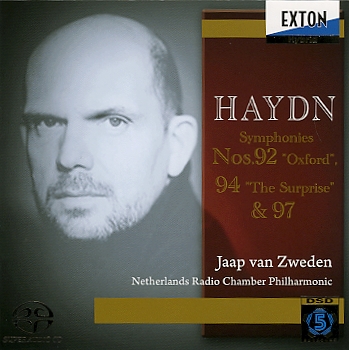
I used the No52’s phono preamp with a whole bunch of my classic jazz albums that had been remastered and recut at 45 RPM. The No52 has a lot of choices to load your phono cartridge, but there is no critical combination of resistive and capacitive loading. You can play around with the various choices in the menu, and let them stay where you like the sound best. In fact, I have several setups for the loading on my own phono preamp, the Manley Steelhead, depending on the album. In this case, I preferred the Steelhead’s tube sound quality to the No52’s neutrality.
The Mark Levinson No52 Stereo Preamplifier On the Bench
Distortion measurements were within an 80 kHz bandwidth. I used the XLR balanced inputs and outputs for the measurements. The volume control was set to 80. The gain setting was at 0 dB, unless otherwise noted.
At 2 volts output, THD+N was a vanishingly low 0.00041%. All of the visible harmonics were at or near – 120 dBV. Distortion this low is totally inaudible.

The graph above was with a gain setting of 0 dB (in the Line Stage Gain menu). This produced 2 volts output with a 2 volt input signal. The three graphs below show what happens when the input remains at 2 volts, but the gain settings are changed to +6 dB, +12 dB, and + 18 dB. You can see that with each increase in 6 dB, the output voltage doubles. The distortion difference (0.0001%) between all four graphs is insignificant. The noise floor does go up with increasing gain settings, and that is why I decided on 0 dB for the setting. It also gave me a volume control play all the way up to 80 dB. However, it was too loud for my listening preference with the volume control above 75 dB. If you obtain a No52, start with 0 dB in the gain setting menu and then work your way up until you have the volume control play that you want, because even at +16 dB gain setting, the noise floor is still only at -120 dB, which is inaudible.
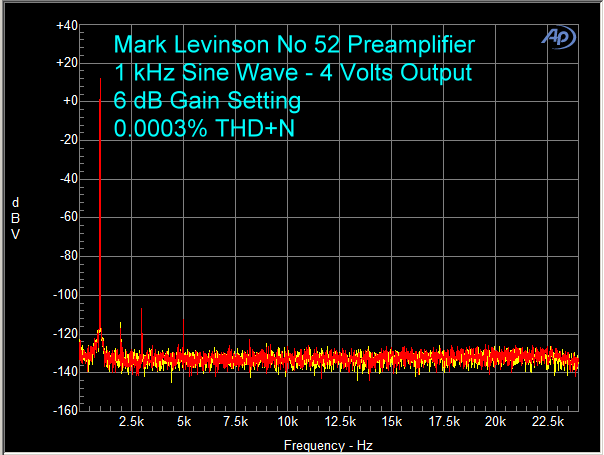
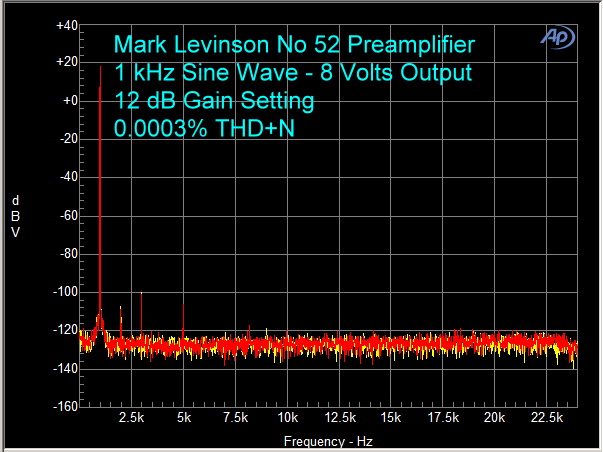

At 5 volts output, distortion was even lower. In fact, this is near the limits of the Audio Precision test instrument. The harmonics are near – 110 dBV, which are still inaudible.
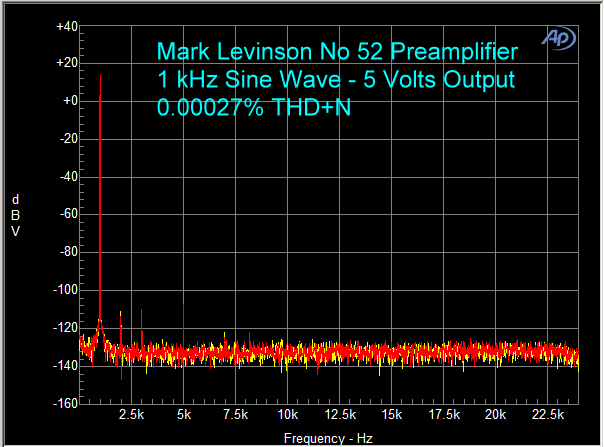
Using 19 kHz and 20 kHz sine wave test tones, the B-A peak at 1 kHz was at – 120 dBV. Only two side bands (one on either side of the two test tones) were visible.
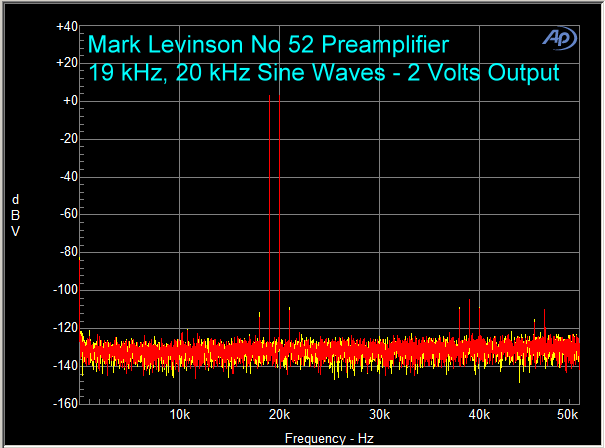
At 5 volts output, the B-A peak at 1 kHz was at – 115 dBV, which is inaudible. Two side peaks on either side of the test tones were visible, which is continued astonishing performance.
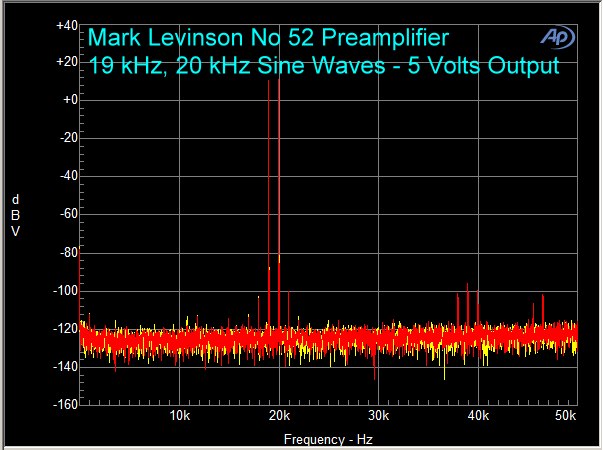
IMD at 2 volts output was below 0.001%. The base of the 7 kHz test tone peak does not have much side band data (in some amplifiers, there is a pyramidal shape to the base, indicating more intermodulation with the 60 Hz test tone that is part of the IMD spectrum). The second harmonic at 14 kHz is below audibility.
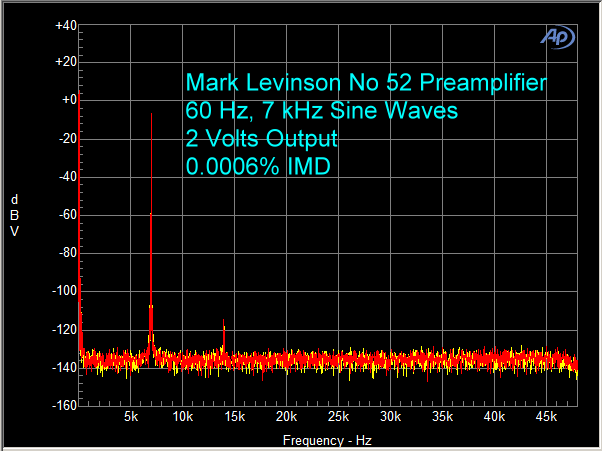
Raising the output to 5 volts resulted in no significant change in the IMD (a difference of 0.0001% is not significant). The noise floor did rise, but this is common, and the noise floor is still below – 120 dB.
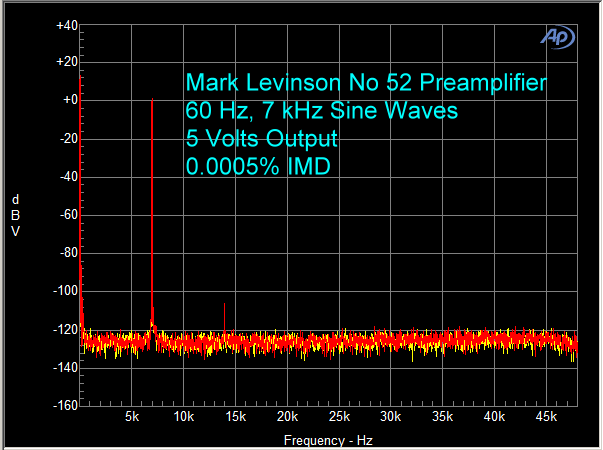
A Hum Spectrum is shown below. The X and Y axis have been expanded to show details at 60 Hz and its multiples. The highest one I can see is at 420 Hz, but, in general, they are all buried in the noise floor. The No52 has a superb power supply.
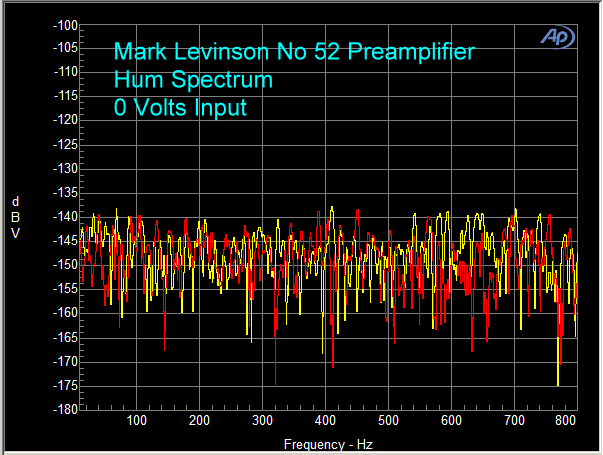
The measured frequency response was 10 Hz to 200 kHz, – 0.4 dB, which is spectacular ! ! The response with the stress load of 600 ohms was identical to the response with the 100 kOhms test load.


The adherence to the RIAA curve was flat to 30 kHz. I used 7.7 ohms and 200 pF capacitance as the load.
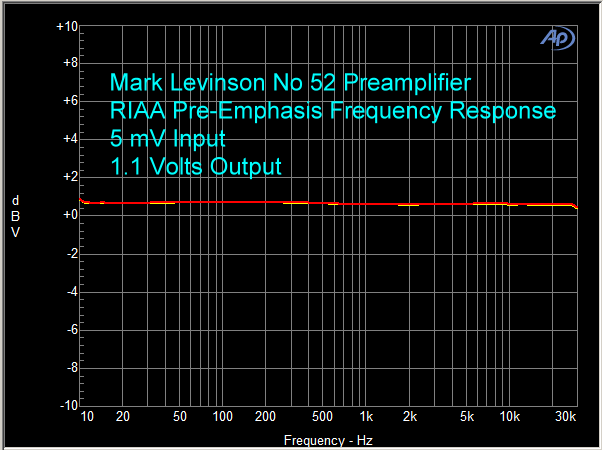
The THD+N vs. Frequency test indicated that distortion at both 2 volts and 5 volts output stayed below 0.0005%. So, distortion at all audible frequencies was essentially negligible. In 20 years of editing Secrets, I have never seen performance like this.
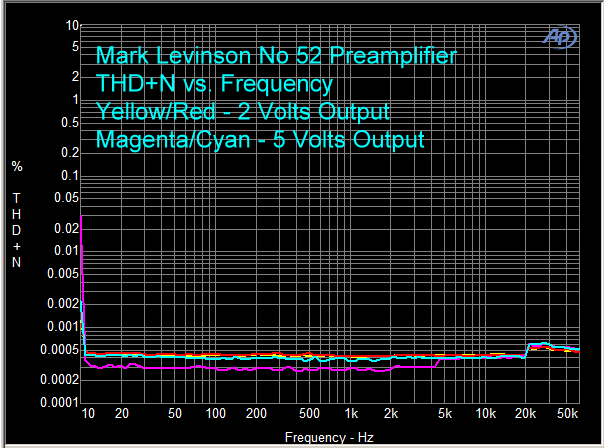
THD+N vs. Output Voltage showed that distortion in a typical range (500 mV – 5 V) stayed mostly well below 0.001%.

Conclusions about The Mark Levinson No52 Stereo Preamplifier
I have reported on many preamplifiers at Secrets, and said good things about most of them, great things about a few of them, but words are not really needed when the bench test data show such amazing performance. The Levinson engineers did a fantastic job building, “the best preampifier they have ever designed”.
It’s a beautiful product to show off, an amazing product to listen to, and it’s not even the most expensive preampifier out there. If you are a Levinson fan, you may have already ordered one of the No52’s, and if you are someone who has been thinking about becoming a Levinson owner, now is the time. I can’t think of any more adjectives to express my admiration for the Mark Levinson No52 Preamplifier. Well done ! ! !


